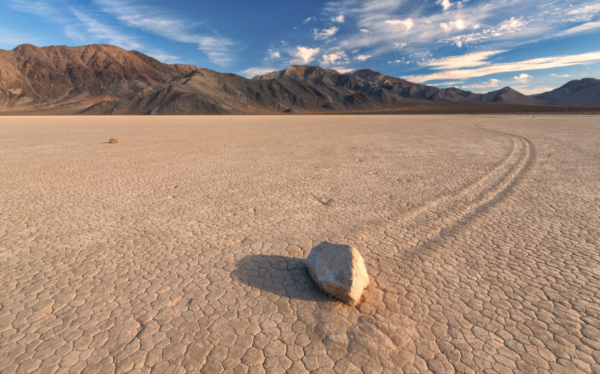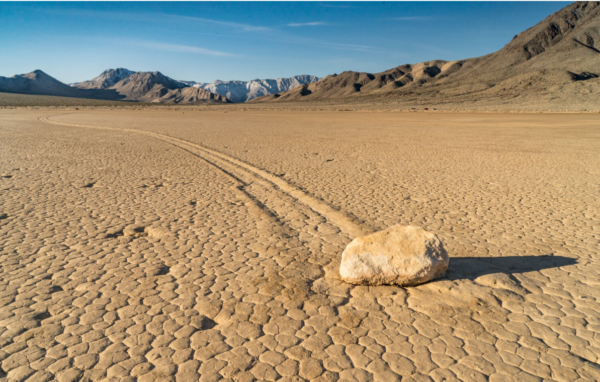In California’s Death Valley National Park in 1915, a prospector named Joseph Crook visited the dried lake-bed of Racetrack Playa and stumbled upon scores of boulders that had apparently moved across the surface, leaving very obvious trails. With some boulders weighing in excess of 300kg, and having moved as far as 250m, it was a perplexing sight that would warrant further scientific research to determine just how this had occurred.
Known as Sailing Stones, this phenomenon was also observed at Little Bonnie Claire Playa in Nevada; rocks seemingly moving and inscribing tracks in the smooth sandy ground without any human interaction. It further confused scientists to find that some trails were perfectly curved while others seemed to have moved in a straight line with sudden shifts to the left or right.

Many theories were thrown out initially. Was it down to magnetic fields, dust devils or was it simply a bizarre prank? Even alien intervention was mentioned, but the idea of an extraterrestrial visiting Earth just to move a few stones around a desolate plain was quickly snuffed out.
It took a NASA scientist named Ralph Lorenz to solve the mystery in 2006 and prove just what was happening to the rocks when nobody was looking. The phenomenon behind the sailing stones was something labelled ‘ice shove’. In winter, Racetrack Playa fills with water and the stones in the lake-bed become encased in ice. Thanks to the buoyancy of ice, even a light breeze can send these boulders ‘sailing’ across the mud at the bottom of the lake. Those with a rough bottom edge leave straight tracks, while those with a smooth edge drift. When the warmer months melt the ice, the water evaporates and leaves only the stones and their trails.
It was found that the rocks can be shoved at speeds of up to 5m per minute, leaving tracks as long as 100m depending on the size and weight of the respective boulder. Some smaller stones turn as they drift, which causes stranger trails in their wake. Rocks that start next to one another may travel parallel before one changes direction and heads off left, right or even backwards.
Lorenz stated that there were a number of conditions that would encourage the sailing stones to move in this way; a natural recipe if you will. Take a flooded surface and thin layer of clay in the bed, add wind and ice floes, then finish off with warming temperatures to remove ice and water.
The study of the sailing stones began shortly after being discovered by Crook, and yet it took 91 years to finally determine the cause. In August 2014, scientists published a time-lapse video of the rocks moving to wrap up their findings and present to the world. Aided by GPS, they documented the movement of some 60 different rocks between the start of December 2013 and end of January 2014. This study proved that the stones were not moving on ‘ice rafts’ as theorized previously and the term ‘ice shove’ came into existence to describe what was actually happening.

Whilst satisfied with their results, the scientists had solved one of nature’s great mysteries and there was to be no more wondering and theorizing to be had. In a way, it is sad that natural phenomena such as the sailing stones have to be analyzed so, as the mystery is what keeps the imagination hooked. In 1952, a park ranger named Louis Kirk recorded his own detailed observations of the stones, including their trail length, width and course. His intention was never to explain the reason behind them. It was simply to investigate and feed his own curiosity.
Despite the mystery being explained, it is still an amazing feat of nature when considering that the right ingredients must be in place for a stone to sail, and a unique sight for visitors to the Racetrack Playa or Little Bonnie Claire Playa.







